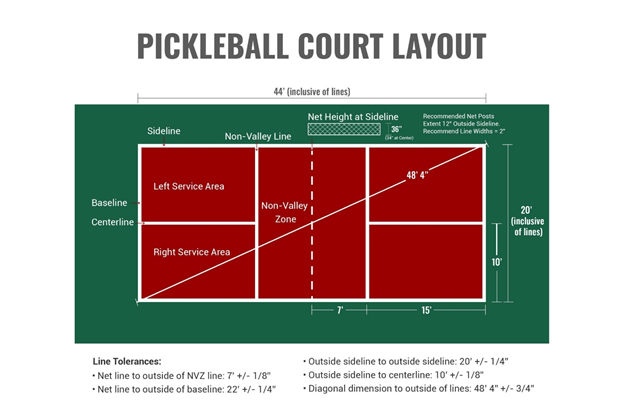Interior and Outdoor Pickleball Court Construction Providers
Interior and Outdoor Pickleball Court Construction Providers
Blog Article
Sustainable Practices in Pickleball Court Building And Construction You Need To Know
As the popularity of pickleball remains to increase, so also does the need for sustainable practices in court construction. This strategy not just addresses ecological issues yet additionally boosts the long life and capability of the courts. From picking green materials to carrying out efficient water drainage and energy-saving lighting remedies, there are countless strategies to think about. Yet, the impact of these methods expands far past the court itself. Comprehending just how each component adds to a more sustainable future invites additionally expedition right into the intricate equilibrium in between leisure growth and ecological stewardship.
Selecting Eco-Friendly Materials
Selecting green materials is an important action in the building of sustainable pickleball courts. The choice of lasting materials not only minimizes environmental influence however likewise boosts the longevity and efficiency of the court. Key products include reused rubber for the surface area, which supplies superb longevity and shock absorption while drawing away waste from land fills.
Additionally, utilizing locally sourced materials minimizes transport emissions and supports local economies. Pickleball court construction. For instance, using native hardwoods for fencing and seating can offer a sustainable visual while guaranteeing strength against the elements.
Incorporating permeable materials for court structures can better add to sustainability by enabling natural water drainage and minimizing overflow. These options not just shield regional communities however also advertise much healthier play environments.
Efficient Water Drainage Solutions
While the option of environmentally friendly products is necessary, applying effective drainage options is similarly crucial for maintaining sustainable pickleball courts. Correct drainage not just secures the court surface area from water damages but additionally lessens erosion and overflow, advertising environmental stability.
Efficient drainage systems can include permeable paving, which allows water to penetrate the ground instead of pooling on the surface area. This lowers the likelihood of standing water, which can cause mold and other maintenance problems. Additionally, including tactically placed drainage networks and swales can guide excess water away from the court area, making sure a dry having fun surface and protecting against dirt erosion.
Using native plant life in the landscape design around the courts can further enhance drainage by taking in excess water and reducing drainage. These plants require much less irrigation and advertise biodiversity, straightening with lasting methods.
Moreover, it is crucial to consistently maintain the drainage system to guarantee its lasting effectiveness. This consists of clearing particles and tracking for clogs. By prioritizing reliable drainage options, pickleball court builders can dramatically contribute to the sustainability and durability of the facility, inevitably benefiting both players and the atmosphere.
Energy-Efficient Lights Options
As the demand for pickleball remains to grow, incorporating energy-efficient lighting options into court layout has actually become progressively vital for sustainability. Traditional illumination systems often consume too much energy, adding to higher operational costs and environmental impact. Consequently, embracing modern-day, energy-efficient modern technologies is essential Check This Out for both new constructions and remodellings.
LED (Light Emitting Diode) illumination stands out as a leading option as a result of its durability and energy savings (Pickleball court construction). Contrasted to standard illumination, LEDs use about 75% this hyperlink much less power and can last approximately 25 times much longer, substantially decreasing maintenance costs. The directional nature of LED lighting lessens light pollution, making certain that lighting is focused on the court rather than surrounding areas.

Sustainable Surface Alternatives
Exploring sustainable surface options for pickleball courts has obtained traction amongst gamers and home builders alike. The focus on environmentally friendly materials not only straightens with the growing environmental page awareness but also improves the efficiency and toughness of the courts.
One preferred option is using recycled rubber, which can be sourced from used tires. This material provides outstanding shock absorption, decreasing the threat of injuries for players while promoting sustainability. In addition, modular ceramic tiles made from recycled plastics supply one more viable choice. These tiles are simple to change and mount, and their adaptability permits for various court setups.
All-natural yard courts are likewise becoming a sustainable option, promoting biodiversity and decreasing the heat island effect. Nevertheless, they call for normal upkeep and water, which might not straighten with all sustainability objectives.

Water Preservation Techniques

One more effective strategy includes the installation of rain harvesting systems. These systems keep and gather rainwater for usage in preserving court surface areas and landscaping. This approach not just conserves safe and clean water however additionally minimizes dependence on local resources.
Additionally, employing drought-resistant landscaping around the courts is essential. Native plants call for less water and are much better adjusted to local environment conditions, therefore lowering overall water usage. In addition, utilizing effective watering systems, such as drip watering, guarantees that water is provided straight to plant origins, reducing dissipation and waste.
Verdict
Incorporating sustainable practices in pickleball court construction significantly contributes to ecological conservation and source effectiveness. By prioritizing these practices, the construction of pickleball courts can align with more comprehensive ecological goals while promoting longevity and capability within areas.
As the popularity of pickleball proceeds to climb, so too does the requirement for lasting methods in court construction.Picking environment-friendly materials is an essential step in the building and construction of lasting pickleball courts. By prioritizing energy-efficient illumination choices, pickleball court fabricators can add to a more lasting future while meeting the demands of players and stakeholders alike.Incorporating lasting surface choices not only boosts the performance of pickleball courts yet also paves the way for executing effective water conservation techniques.Incorporating sustainable techniques in pickleball court construction substantially adds to environmental preservation and source performance.
Report this page